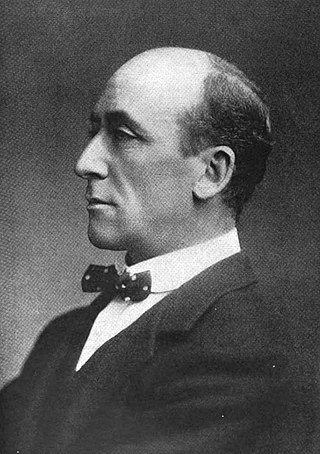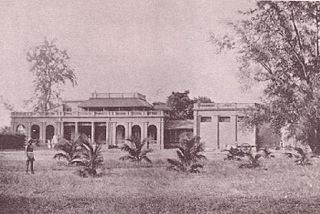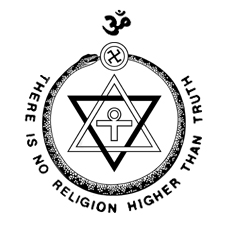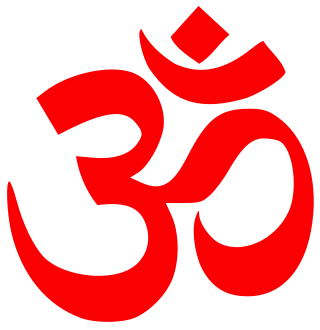Related Research Articles

Algernon Henry Blackwood, CBE was an English broadcasting narrator, journalist, novelist and short story writer, and among the most prolific ghost story writers in the history of the genre. The literary critic S. T. Joshi stated, "His work is more consistently meritorious than any weird writer's except Dunsany's" and that his short story collection Incredible Adventures (1914) "may be the premier weird collection of this or any other century".

The Theosophy Society was founded by Helena Petrovna Blavatsky and others in 1875. The designation 'Adyar' is sometimes added to the name to make it clear that this is the Theosophical Society headquartered there, after the American section and some other lodges separated from it in 1895, under William Quan Judge. In 1882, its headquarters moved with Blavatsky and president Henry Steel Olcott from New York to Adyar, an area of Chennai, India.

Annie Besant was a British socialist, theosophist, freemason, women's rights and Home Rule activist, educationist, and campaigner for Indian nationalism. She was an ardent supporter of both Irish and Indian self-rule. She became the first female president of the Indian National Congress in 1917.

The United Lodge of Theosophists or ULT is an informal and wholly voluntary association of students of Theosophy. It was founded in 1909, mainly through the efforts of Robert Crosbie. The first parent lodge of the ULT was started in Los Angeles by Robert Crosbie and seven other associates through the adoption of its Declaration on February 18, 1909. Owing largely to the revival efforts of B.P. Wadia after Crosbie's death, there are currently about twenty active lodges spread all over the world. The ULT is considered to be part of the second generation or the third section of the Theosophical Movement started in 1875 by H.P. Blavatsky in New York. Presently, it is also one of the existing four main "branches" of the original Theosophical Movement. The following founding principles when taken as a whole, sets apart the ULT from the other Theosophical Organizations:

The historical Vedic religion, also called Vedicism or Vedism, and sometimes ancient Hinduism or Vedic Hinduism, constituted the religious ideas and practices prevalent amongst the Indo-Aryan peoples of the northwest Indian subcontinent during the Vedic period. These ideas and practices are found in the Vedic texts, and some Vedic rituals are still practiced today. The Vedic religion is one of the major traditions which shaped modern Hinduism, though present-day Hinduism is significantly different from the historical Vedic religion.

Bhojpuri is an Indo-Aryan language native to the Bhojpur-Purvanchal region of India and the Terai region of Nepal and. It is chiefly spoken in eastern Uttar Pradesh, western Bihar, and northwestern Jharkhand in India, as well as western Madhesh, eastern Lumbini, southeastern Gandaki, and southwestern Bagmati in Nepal. Bhojpuri is also widely spoken by the diaspora of Indians descended from those who left as indentured laborers during the colonial era. It is an eastern Indo Aryan language and as of 2000 it is spoken by about 5% of India's population. Bhojpuri is a descendant of Magadhi Prakrit and is related to Maithili, Magahi, Bangla, Odia, Assamese, and other eastern Indo-Aryan languages.

Isis Unveiled: A Master-Key to the Mysteries of Ancient and Modern Science and Theology, published in 1877, is a book of esoteric philosophy and Helena Petrovna Blavatsky's first major self-published major work text and a key doctrine in her self-founded Theosophical movement.

Root races are concepts in the esoteric cosmology of Theosophy. As described in Helena Petrovna Blavatsky's book The Secret Doctrine (1888), these races correspond to stages of human evolution, and existed mainly on now-lost continents. Blavatsky's model was developed by later theosophists, most notably William Scott-Elliot in The Story of Atlantis (1896) and The Lost Lemuria (1904). Annie Besant further developed the model in Man: Whence, How and Whither (1913). Both Besant and Scott-Elliot relied on information from Charles Webster Leadbeater obtained by "astral clairvoyance". Further elaboration was provided by Rudolf Steiner in Atlantis and Lemuria (1904). Rudolf Steiner, and subsequent theosophist authors, have called the time periods associated with these races Epochs.

Braj Basi Lal was an Indian writer and archaeologist. He was the Director General of the Archaeological Survey of India (ASI) from 1968 to 1972 and has served as Director of the Indian Institute of Advanced Studies, Shimla. Lal also served on various UNESCO committees.
Bahman Pestonji Wadia or Bomanji Pestonji Wadia was an Indian theosophist and labour activist.

The Theosophist is the monthly journal of the international Theosophical Society based in Adyar, India. It was founded in India in 1879 by Helena Blavatsky, who was also its editor. The journal is still being published till date. For the year 1930, the journal was published in Hollywood, California by Annie Besant and Marie Russak Hotchener, but it returned to Adyar in 1931. The journal features articles about philosophy, art, literature and occultism.

Henry St. Clair Whitehead was an American Episcopal minister and author of horror, some non fiction and fantasy fiction.

Geoffrey Hodson was an occultist, Theosophist, Co-Freemason, mystic, Liberal Catholic priest, philosopher and esotericist, and a leading light for over 70 years in the Theosophical Society.

The Theosophical Movement is a monthly magazine that was started by the United Lodge of Theosophists India under B.P. Wadia on 17 November 1930. It is a magazine that is devoted to the living of the higher life. The monthly magazine is edited in Mumbai, India, by associates of the ULT. Its print and electronic editions have subscribers all over the world. All articles in the magazine are unsigned, except those that had been written by H.P.B., W.Q.J. or others who had made signed contributions in the older Theosophical magazines. Furthermore, articles in the magazine distinctly avoid all references to personal opinions and experiences of the author. These are directly in keeping with one of the core tenets of anonymity and impersonality of ULT associates as expressed by Robert Crosbie. The magazine is dedicated to:
Ananda Chandra Barua (1907–1983) was a writer, poet, playwright, translator, journalist and actor from Assam. He is popularly known as Bokulbonor Kobi in Assamese literacy society. He was honoured with, most notably the Padma Shri title and Sahitya Akademi award.

Sophia Wadia, née Sophia Camacho, was a Colombian-born naturalized Indian theosophist, littérateur, the founder of PEN All India Centre and the founder editor of its journal, The Indian PEN. She also cofounded The Indian Institute of World Culture, Bangalore and the Asian Book Trust, Bombay. The Government of India honoured Wadia in 1960, with the award of Padma Shri, the fourth highest Indian civilian award, for her services to the nation.

Theosophy is a religious and philosophical system established in the United States in the late 19th century. Founded primarily by Russian mystic and spiritualist Helena Blavatsky, and based largely on her writings, it draws heavily from both older European philosophies such as Gnosticism and Neoplatonism and Indian religions such as Hinduism and Buddhism. Although many adherents maintain that Theosophy is not a religion, it is variably categorized by religious scholars as both a new religious movement and a form occultism from within Western esotericism.

Hinduism is regarded by modern Theosophy as one of the main sources of "esoteric wisdom" of the East. The Theosophical Society was created in a hope that Asian philosophical-religious ideas "could be integrated into a grand religious synthesis." Prof. Antoine Faivre wrote that "by its content and its inspiration" the Theosophical Society is greatly dependent on Eastern traditions, "especially Hindu; in this, it well reflects the cultural climate in which it was born." A Russian Indologist Alexander Senkevich noted that the concept of Helena Blavatsky's Theosophy was based on Hinduism. According to Encyclopedia of Hinduism, "Theosophy is basically a Western esoteric teaching, but it resonated with Hinduism at a variety of points."
According to some literary and religious studies scholars, modern Theosophy had a certain influence on contemporary literature, particularly in forms of genre fiction such as fantasy and science fiction. Researchers claim that Theosophy has significantly influenced the Irish literary renaissance of the late 19th and early 20th centuries, notably in such figures as W. B. Yeats and G. W. Russell.
Josephine Maria Ransom, née Davies (1879-1960) was an Australian Theosophist and writer. She served as General Secretary of three different national sections of the Theosophical Society, and wrote A Short History of the Theosophical Society. Ransom was also Honorary Secretary of the Britain and India Association, and editor of its magazine Britain and India.
References
- 1 2 W. Dallas TenBroeck. "Memorandum". Katinka Hesselink.Net. Retrieved 28 October 2016.
- ↑ The Indo-Asian culture. Indian Council for Cultural Relations. 1 January 1971. p. 86. Retrieved 30 March 2012.
- ↑ Olav Hammer, Mikael Rothstein. Handbook of the Theosophical Current. Brill Publishing, 2013 ISBN 9004235965 (p. 83).
- 1 2 Sisir Kumar Das (1991). History of Indian Literature: 1911-1956, struggle for freedom: triumph and tragedy. Sahitya Akademi. p. 641. ISBN 978-81-7201-798-9 . Retrieved 28 July 2015.
- 1 2 "The April Reviews", The Spectator magazine. 9 April 1932 - (p. 530)
- ↑ "The Aryan Path Paved the way for 'The International PEN' in India: A history". PEN West Bengal. Retrieved 28 October 2016.
- ↑ Bomanji Pestonji Wadia (1881 - 1958) Biography of B.P. Wadia. Retrieved 8 August 2013.
- ↑ "The Aryan Path". South Asia Archive. Retrieved 28 October 2016.
- ↑ Frederick George Aflalo (1904). The sportsman's book for India. H. Marshall & Son. p. 161 . Retrieved 30 March 2012.
- ↑ Advertisement for The Aryan Path, The Saturday Review of Literature, 17 March 1934, (p. 565)
- ↑ Advertisement for The Aryan Path, The Saturday Review of Literature, 16 September 1933, (p. 118).
- ↑ Advertisement for The Aryan Path, The Bookman (U.K.), December 1933, (p. 201)
- ↑ Harry Oldmeadow, Journeys East: 20th Century Western Encounters with Eastern Religious Traditions. World Wisdom, 2004, ISBN 0941532577 (p. 71).
- ↑ Algernon Blackwood, "On Reincarnation". The Aryan Path, I, (p. 155), (Mar. 1930).
- ↑ Plummer, Brenda Gayle (24 June 1996). Rising wind: Black Americans and U.S. foreign affairs, 1935-1960. Univ of North Carolina Press. p. 91. ISBN 978-0-8078-4575-2 . Retrieved 30 March 2012.
- ↑ "Several articles have appeared in the Aryan Path recently, deploring the effects of race prejudice in America, Africa and India. "Theosophists find followers among N.Y. Intelligentsia". The Afro American , 6 October 1934, (p. 12).
- ↑ Kuruvila Pandikattu, Gandhi: The Meaning of Mahatma for the Millennium. CRVP, 2001 ISBN 1565181565 (p. 249).
- ↑ Dan Martin, Unearthing Bon Treasures: Life and Contested Legacy of a Tibetan Scripture Revealer, With a General Bibliography of Bon. Brill, 2001 ISBN 9004121234, (pp. 390-391).
- ↑ Jonathan Rosenberg (2006). How Far the Promised Land?: World Affairs And the American Civil Rights Movement from the First World War to Vietnam. Princeton University Press. p. 266. ISBN 978-0-691-00706-9 . Retrieved 30 March 2012.
- ↑ Project Muse (1960). Journal of the history of ideas. Journal of the History of Ideas, Inc. p. 42. Retrieved 30 March 2012.
- ↑ All-India Centre of the P.E.N.; P.E.N. All-India Centre, Bombay (1963). The Indian P.E.N. P.E.N. All-India Centre. p. 197. Retrieved 30 March 2012.